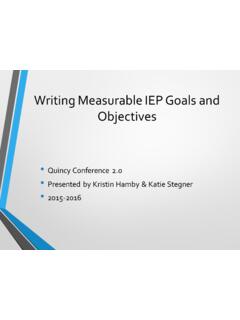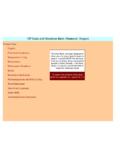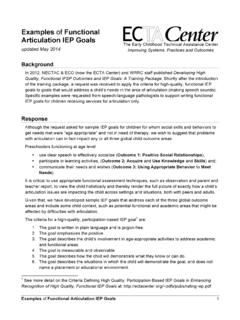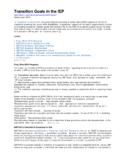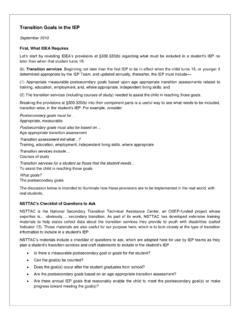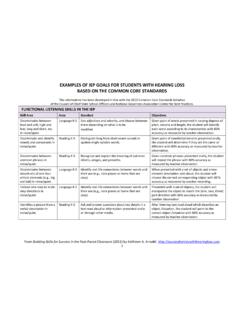Transcription of Writing IEP Goals and Objectives for Authentic ...
1 Linda Burkhart and Gayle Porter - July, 2009 and Feb, 2010 Writing IEP Goals and Objectives for Authentic Communication - for Children with Complex Communication Needs Adopt and Share Beliefs and Basic Assumptions about Communication: Not having speech is not the same as not understanding Everyone Communicates Communication is Messy Communication is Dynamic and Raw - Not Edited and Polished - Not Sterile Like Performing a Script Communication is Interactive - Not a One Way Process. It is dependent Upon the Communication Partner s Responses. Not All Thought Out Ahead of Time Requiring too much perfection and correctness early in the language learning process, can derail the developmental process, by undermining the child s confidence as a learner. When the goal is communication, we need to accept, value and expand upon whatever the child does Communication is about something we don t already know Autonomy of Message is Critical Must be the Child s Message - Even if She Needs Help to Communicate it Not Just a Response to the Options Provided by Others Communication is NOT just an activity.
2 It occurs all day long in a variety of natural contexts Communication Begins with Intent Getting from Intent to Action is What is Difficult for many children who have multiple disabilities The result of the effort, must be worth the effort Keep your expectations open Remembering the Intent of Communication: Begin with the understanding that expressive communication is a function of the child s intent. It depends upon the child s ability to communicate an autonomous message - to say what they want to say, when they want to say it. Being too narrow in Writing the measurable outcome of a goal that states what a child must say and how often he must say it, can actually lead to Linda Burkhart and Gayle Porter - July, 2009 and Feb, 2010 inappropriate instruction and decreased opportunities for learning. The focus of instruction may then become contrary to the child s broader development of autonomous, pragmatically appropriate communication.
3 In Research and Clinical Practice: Pragmatic Use of Communication is Measured by it s Appropriateness, Not by Quantity Appropriateness is dependent on the interaction with communication partners in specific contexts Many self-initiated communication turns are actually non-obligatory. This means that you (the communicator) choose to take the turn or not, you choose to ask a question when you have one, you ask for something when you want it, and not when you don t. A goal which requires a child to comment, ask a question or request at a specific time may in fact lead to practices which reinforce the child s concept that communication is a meaningless task, rather than a powerful personal tool I can use to communicate my own messages. Examples of Faulty Communication Goals : During snack, (Name) will request a drink 4 out of 5 times Problems with this goal Does (Name) want a drink? How do you know if he is requesting a drink 4 out of 5 times that he wants a drink? What determines 5 times?
4 NOTE: If someone has to ask him if he wants a drink 5 times during snack, then he is using the pragmatic intent of responding to a question not requesting . What does he learn about communication if he has to ask for drink when he doesn t want one? What if he wants to say I want to go play now ? Would that be marked wrong on his data chart? According to this objective it would be wrong, but according to being able to communicate his own ideas, it is very right. During math activities (Name) will respond to the question: How many? when presented with a group of 1 -10 items Problems with this goal If the child answers with an incorrect number, then the child has met the communication component of this goal: respond to the question how many, but has not met the criteria on the content of this goal understanding quantities It is very easy to inadvertently mix content and communication in the same goal, when the child is not yet a competent communicator. This makes it difficult to know what the child is achieving - a correct answer - or an appropriate form of communication.
5 We need to be very careful that the goal is actually measuring what the child needs to learn. Note: For a typical child who puts her hand up and answers a wrong number such as 7 , we Linda Burkhart and Gayle Porter - July, 2009 and Feb, 2010 wouldn t say that the child can t speak, we would say that she can not count correctly. We need to ensure that communication Goals and Objectives : Incorporate flexibility for the child to say what they want to say when they want to say it Reflect increasing the ability of the child to use a broad range of communicative functions to express real ideas in real situations through multiple modalities. Do not require the child will have to communicate what someone else wants her to say . This concept also has implications for how progress toward a goal will be measured. Testing situations that present an artificial context, will not provide a window into the child s true developing communication skills. Progress for communication development is more appropriately observed in natural contexts throughout the day as the child begins to take up opportunities to express ideas that are meaningful to her.
6 Data collection will need to reflect the context as well as the communicative functions that the child expresses when the child sees a reason to communicate and then successfully transmits a message that is understood by her communication partner. Goals for Beginning Communicators: Looking at language development for typical children, there is a long period of time, when the child is learning to express ideas and experiment with language according to her own agenda. This is an interactive process where the child learns through feedback from communication partners, to refine and expand her abilities. Only once the child has achieved some level of communicative competence for expressing her own ideas, is she then able to respond to another person s agenda to answer their questions. Receptive language ability in typical children, is often observed through the child s behavior in response to others, as well as what the child is able to express in appropriate contexts. The young child does not often demonstrate her receptive abilities through responding to direct questions.
7 She may however, go get her shoes or move towards the door when someone suggests going outside to play, or she may say out . Any of these actions will show that she understood what was said. In other cases she may point to, or look toward an object that someone else is talking about, even if she cannot yet respond to a direct question. Because Linda Burkhart and Gayle Porter - July, 2009 and Feb, 2010 children with complex communication needs may have difficulty moving their bodies, directing their gaze, or expressing their ideas to demonstrate understanding, it can be difficult to know how much language they are processing. Measuring a behavior may not give us a clear indication of what is being understood by these children. While taking data on a child s ability to answer questions in a testing situation might be easier for the adult, it does not give us evidence of the child s developing language abilities. When answering questions becomes the focus of language instruction and testing, then the natural process of language learning through interaction is disrupted.
8 The only way to assess the child s developing abilities for communication is to collect data over time in natural contexts where the child can demonstrate her communicative competence. There is a Catch 22 when it comes to teaching communication skills for children who do not have a current means of communication. It is frequently impossible to know how a child will progress with language, until an accessible form of language is placed in the child s environment for her to learn over time. And it is difficult to know the best accessible language system for a child, without a long term dynamic assessment process. Dynamic Assessment happens over time. For many children who have complex communication needs, it is impossible to do a one time assessment and learn enough about the child to write meaningful Goals and Objectives . School systems often do not recognize this process, and expect the team to be able to assess and write Goals over the short term. This often results in narrow, task specific, meaningless Goals that are not flexible enough to follow the child s evolving learning requirements.
9 Therefore, initial Goals may need to be written in a manner that allows for exploration of a range of strategies to determine the most appropriate learning requirements for each child. Strategies: Strategies used to facilitate the achievement of Goals and Objectives may be written into the Goals or may be itemized in a section for accommodations or methods and materials. Examples might include some of the following; Access to a comprehensive language system that the child can learn to use Trained communication partners who can model augmentative and/or alternative language systems in natural contexts - a multi-modal language learning environment Linda Burkhart and Gayle Porter - July, 2009 and Feb, 2010 Interaction with communication partners who model the use of the communication system that the child will use Trained communication partners who can identify attempts at initiating communication and read and expand upon subtle communicative signals from the child Trained communication partners who can assist with operation of communication system to support an autonomous message from the child Engineered communication opportunities within natural contexts Opportunities to communicate Models of ideas on what to communicate in a variety of situations Training of communication partners about beliefs and expectations for training Sufficient wait time without interrupting thought process Strategic and natural feedback on attempts and successful communications A communication environment of people (adults and peers)
10 Who value and validate the use of AAC to communicate thoughts and ideas Purpose, motivation, and intent to communicate something Positioning equipment that supports and allows for controlled movement Frequent monitoring of the child s position and position of equipment in relation to the child Writing IEP Goals and Objectives : Goals must be measurable, but do not have to be measured in a testing format. It is often more appropriate to write the goal as measured over natural contexts throughout the day. For example, the child will _____ more than ___ number of times within the natural context of school activities. To make this type of data collection practical, reasonable time samples across days, weeks or months would need to be selected. For children who have very little expressive language, data might be collected every time the child expresses herself in the classroom. For the child who communicates only a few times a day, a full day may be selected periodically.


